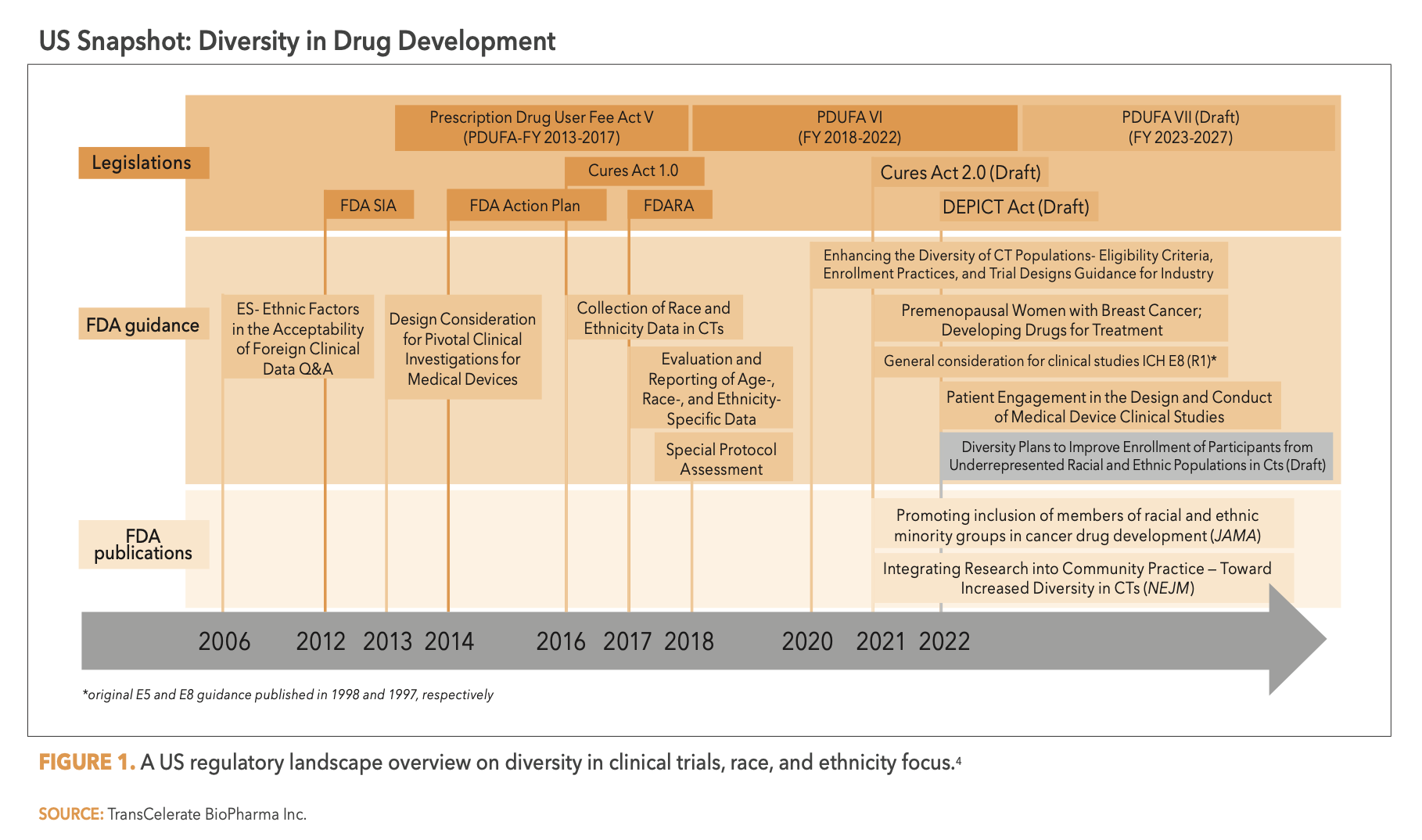Tips and Tools to Overcome DE&I Challenges in Clinical Trials
Navigating FDA’s draft guidance and heightened diversity recommendations.

FDA has called upon the entire drug development industry to do more to improve racial and ethnic diversity in clinical trials. In its April 2022 draft guidance, it recommends that sponsors submit a “race and ethnicity diversity plan” to the investigational new drug (IND) application or the investigational device exemption (IDE) application.1 FDA further notes that it will consider this plan an “important part” of a product’s development program.
The draft guidance offers a glimpse into when —and how—the FDA expects sponsors to build a diversity plan into their drug development process. However, it also acknowledges that while these recommendations are a much-needed first step, they remain limited in scope. The text states:
“…this guidance focuses specifically on racial and ethnic demographic characteristics of study populations… However, FDA advises sponsors to seek diversity in clinical trial enrollment beyond populations defined by race and ethnicity, including other underrepresented populations defined by demographics such as sex, gender identity, age, socioeconomic status, disability, pregnancy status, lactation status, and comorbidity.”
Thus, even as the guidance is finalized, sponsor companies and other industry stakeholders seek added clarity on this critical issue. The idea that clinical trials must better represent their affected patient populations is not new, but it entails significant challenges. Some sponsors are starting to overcome these challenges by collaboratively creating practical tools and possible approaches for increasing participant diversity, equity, and inclusion (DE&I).
Sustainable DE&I strategies
About a year before its draft guidance was released, FDA’s Center for Drug Evaluation and Research (CDER) published a Drug Trials Snapshots Summary Report that reviewed the clinical trial demographics for drugs approved in 2020.2 It found that 75% of participants were white, 8% were Black or African American, 6% were Asian, and 11% were Hispanic.
Since 2015, CDER’s reports have offered transparency into clinical trial diversity by race, ethnicity, gender, and age. Other organizations, too, have tried to drive awareness and change. For example, TransCelerate BioPharma’s Diversity of Participants in Clinical Trials Initiative was formed to work on developing tools to help sponsors and others better achieve DE&I objectives in clinical trials.
TransCelerate’s initiative recognizes that improving diversity in clinical trials is larger than an R&D issue or a sponsor-specific issue. To overcome common, industry-wide obstacles, we have begun proposing more sustainable DE&I practices. Among the proposals gathered to share with the industry are the following five solutions to common challenges:
Challenge #1: Complexity
Cultivating diversity in clinical trials is complex by its very nature. Just as there is no one root cause for the lack of diversity, there is no single solution for achieving diverse representation. It is not a “project” with a defined end date but rather an evolving and ongoing effort. Consequently, organizations should be prepared for shifts and changes over time.
One strategy: Commit to collaboration for the long term
DE&I efforts cannot be achieved in isolation. Instead, every stakeholder in the clinical trial continuum has a role to play.
Changing existing processes will take patience, time, and collaboration. Researchers, sites, regulators, sponsors, CROs, patient advocacy groups, and others should consider earlier and more frequent communication than they might have done in the past. To improve transparency about efforts to increase diversity in trials and identify opportunities for collaboration to enhance ongoing actions, stakeholders can leverage the Reference Table and Visual Landscape of Available Resources that summarizes publicly available tools and resources published by many organizations for improving diversity of participants in clinical studies.3
Challenge #2: The regulatory landscape
Although the events of recent years have placed DE&I in the spotlight, regulators have been moving toward greater clinical trial inclusivity for years. A brief snapshot of US legislation, FDA guidance, and FDA publications since 2006 shows a flurry of activity.

One strategy: Understand the ongoing regulatory evolution
FDA’s most recent draft guidance indicates that the agency expects not only to see a race and ethnicity diversity plan but also for sponsors to have ongoing, open dialogue with FDA about it. The guidance notes, “This Plan should be discussed with the FDA as soon as practicable during medical product development.”
For sponsors, FDA’s desire to see and discuss a DE&I plan at the IND stage signals a greater need to bring both DE&I and regulatory considerations to the development table. Therefore, organizations may want to consider pulling together a cross-functional DE&I team that monitors the regulatory landscape and supports implementation. Organizations can consider the US Regulatory Landscape: Diversity in Clinical Trials resource to help identify key US legislation and FDA policy, regulation, and guidance as well as regulatory precedent to understand and improve diversity and inclusion of adult patients in clinical trials.4
Challenge #3: Partnering with key stakeholders
Building solid relationships with sites, support vendors, and others in the development lifecycle takes time and effort. Unfortunately, time is typically precious in clinical trials. Sponsors may wish or need to add to and further expand its network of partners that help support and run the sponsor’s trials. These efforts may take some thought and time, especially if these efforts entail bringing into the sponsor’s network sites or other stakeholders that have limited or no familiarity with the clinical trial process.
One strategy: Incorporate sites and other partners into the diversity plan
Who better understands underrepresented communities than those who live, work, and serve them? That may mean expanding the sponsor’s network to include sites, investigators, and advocacy groups within those communities and including partners such as CROs as sources for identifying and developing solutions to achieve DE&I clinical trials objectives.
Sponsors should also consider asking sites for suggestions on how best to connect with their diverse patient populations. Companies can leverage the Community-Based Site Engagement and Capacity Building resource to better understand strategies that sponsors, sites, and others have taken to enhance engagement and capacity building for community-based sites.5 Additionally, the Site Engagement and Capacity Building Considerations for DEICT toolkit shares potential mitigation considerations designed to support efforts to sustainably partner with sites to enable the enrollment and retention of underrepresented patient populations.6
Challenge #4: Epidemiology data
FDA’s draft guidance notes, “Sponsors should define enrollment goals for underrepresented racial and ethnic participants as early as practicable in clinical development for a given indication.”1 The whole diversity plan relies on having a “gold standard” for epidemiology data. Yet, for some disease states, such data is not readily available. One of the most significant difficulties confronting the industry currently is a lack of comprehensive epidemiology data to inform enrollment goals for certain studies.
One strategy: Leverage collaborative data-sharing relationships
In such instances, companies may want to seek opportunities to work together with other stakeholders to critically think through how to find or generate baseline prevalence and enrollment data. For example, through TransCelerate’s Race & Ethnicity Enrollment Data Benchmarking effort, a subset of member companies participating in the diversity initiative are exploring how to share summary statistics of US participants enrolled in studies for seven disease states since 2011—specifically looking at race, ethnicity, age, and sex in cancer and inflammation and immunology trials. The goal is to develop proposed benchmarks that identify the disparity between disease prevalence and study representation among racial or ethnic groups.
Challenge #5: Patient engagement
Appropriate and relevant outreach is vital, especially in communities where a lack of trust and awareness about clinical trials may pose sizable obstacles.
One strategy: Understand & meet diverse patient populations wherever they are
As one sponsor-aimed tool suggests, engaging underrepresented patient populations to help create patient recruitment and retention strategies should be a key operational consideration.7 Sponsors may want to elicit the community’s guidance to understand the best methods for reaching, educating, and talking with prospective patients. Who are the leaders and decision-makers within the community? Knowing this can help inform the communication strategy.
Other aspects to address might include:
- Communication methods:e.g., social media, signage, marketing materials.
- Messaging: Does it resonate with the community? Consider cultural sensitivity.
- Reading comprehension level: Is it appropriate for the community?
- Language: Consider the language used and whether the dialect matches that of the intended community.
- Imagery: Is it culturally sensitive and relevant?
Progress through collaboration
In its introduction, FDA states it “is publishing this guidance to provide detail on what sponsors should include in a race and ethnicity diversity plan,” outlining one of the lenses through which the agency will view new drug and device applications going forward. It puts the onus on us all to overcome challenges and include more diverse patient populations throughout the drug development lifecycle. By working in the true spirit of collaboration, stakeholders are already identifying ways to mobilize and make it happen.
Ashley Pachter, program director, TransCelerate BioPharma Inc.
References
- FDA. “Diversity Plans to Improve Enrollment of Participants from Underrepresented Racial and Ethnic Populations in Clinical Trials — Guidance for Industry.” https://www.fda.gov/media/157635/download
- Center for Drug Evaluation and Research, FDA. “2020 Drug Trials Snapshots Summary Report.” https://www.fda.gov/media/145718/download
- TransCelerate BioPharma Inc. “Diversity Roundtable Reference Table and Visual Landscape of Available Resources.” https://www.transceleratebiopharmainc.com/wp-content/uploads/2022/02/Diversity-Roundtable-Reference-Table-and-Visual-Landscape-of-Available-Resources-1.pdf
- TransCelerate BioPharma Inc. “U.S. Regulatory Landscape: Diversity In Clinical Trials.” Page 23. https://www.transceleratebiopharmainc.com/wp-content/uploads/2022/03/TransCelerate-Regulatory-Landscape_Diversity.pdf
- TransCelerate BioPharma Inc. “Diversity Community-Based Site Engagement and Capacity Building.” https://www.transceleratebiopharmainc.com/wp-content/uploads/2022/10/Diversity-Community-Based-Site-Engagement-and-Capacity-Building.pdf
- TransCelerate BioPharma Inc. “Site Engagement and Capacity Building Considerations for DEICT toolkit.” https://www.transceleratebiopharmainc.com/wp-content/uploads/2022/11/Sponsor-Toolkit-Site-Engagement-and-Capacity-Building-Considerations-for-Diversity-Equity-and-Inclusion-of-Participants-in-Clinical-Trials.pdf
- TransCelerate BioPharma Inc. “Collaboration Hub Sponsor Toolkit: Portfolio and Program-Level Considerations for Diversity, Equity and Inclusion of Participants in Clinical Trials (DEICT).” https://www.transceleratebiopharmainc.com/wp-content/uploads/2022/06/Sponsor-Toolkit-Program-Portfolio-Considerations.pdf
